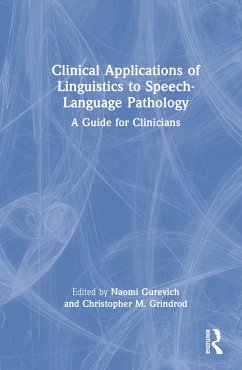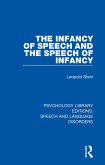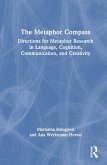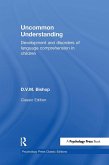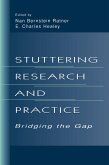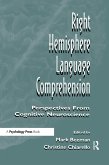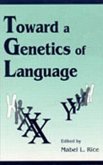Clinical Applications of Linguistics to Speech-Language Pathology
A Guide for Clinicians
Herausgeber: Gurevich, Naomi; Grindrod, Christopher M
Clinical Applications of Linguistics to Speech-Language Pathology
A Guide for Clinicians
Herausgeber: Gurevich, Naomi; Grindrod, Christopher M
- Gebundenes Buch
- Merkliste
- Auf die Merkliste
- Bewerten Bewerten
- Teilen
- Produkt teilen
- Produkterinnerung
- Produkterinnerung
Clinical Applications of Linguistics to Speech-Language Pathology is a practical guide that provides linguistically grounded approaches to clinical practice. It introduces key disciplines and discusses how they form a basis for assessment and treatment of individuals with communication differences or disorders.
Andere Kunden interessierten sich auch für
![The Infancy of Speech and the Speech of Infancy The Infancy of Speech and the Speech of Infancy]() Leopold SteinThe Infancy of Speech and the Speech of Infancy153,99 €
Leopold SteinThe Infancy of Speech and the Speech of Infancy153,99 €![The Metaphor Compass The Metaphor Compass]() Marianna BolognesiThe Metaphor Compass174,99 €
Marianna BolognesiThe Metaphor Compass174,99 €![Uncommon Understanding (Classic Edition) Uncommon Understanding (Classic Edition)]() Dorothy V M BishopUncommon Understanding (Classic Edition)198,99 €
Dorothy V M BishopUncommon Understanding (Classic Edition)198,99 €![Stuttering Research and Practice Stuttering Research and Practice]() Stuttering Research and Practice197,99 €
Stuttering Research and Practice197,99 €![Right Hemisphere Language Comprehension Right Hemisphere Language Comprehension]() Right Hemisphere Language Comprehension197,99 €
Right Hemisphere Language Comprehension197,99 €![Toward a Genetics of Language Toward a Genetics of Language]() Toward a Genetics of Language126,99 €
Toward a Genetics of Language126,99 €![Teaching Written English Teaching Written English]() Ronald V WhiteTeaching Written English153,99 €
Ronald V WhiteTeaching Written English153,99 €-
-
-
Clinical Applications of Linguistics to Speech-Language Pathology is a practical guide that provides linguistically grounded approaches to clinical practice. It introduces key disciplines and discusses how they form a basis for assessment and treatment of individuals with communication differences or disorders.
Hinweis: Dieser Artikel kann nur an eine deutsche Lieferadresse ausgeliefert werden.
Hinweis: Dieser Artikel kann nur an eine deutsche Lieferadresse ausgeliefert werden.
Produktdetails
- Produktdetails
- Verlag: Taylor & Francis
- Seitenzahl: 242
- Erscheinungstermin: 9. November 2022
- Englisch
- Abmessung: 234mm x 156mm x 16mm
- Gewicht: 535g
- ISBN-13: 9780367492915
- ISBN-10: 0367492911
- Artikelnr.: 64687758
- Herstellerkennzeichnung
- Libri GmbH
- Europaallee 1
- 36244 Bad Hersfeld
- gpsr@libri.de
- Verlag: Taylor & Francis
- Seitenzahl: 242
- Erscheinungstermin: 9. November 2022
- Englisch
- Abmessung: 234mm x 156mm x 16mm
- Gewicht: 535g
- ISBN-13: 9780367492915
- ISBN-10: 0367492911
- Artikelnr.: 64687758
- Herstellerkennzeichnung
- Libri GmbH
- Europaallee 1
- 36244 Bad Hersfeld
- gpsr@libri.de
Naomi Gurevich, PhD, CCC-SLP, is Assistant Professor in the Department of Communication Sciences and Disorders at Purdue University Fort Wayne, USA. Her research interests combine her background in phonology with acquired language disorders. She has previously authored two books in these areas. Christopher M. Grindrod, PhD, is Assistant Professor in the Department of Communication Sciences and Disorders at Purdue University Fort Wayne, USA. His research focuses on investigating language impairments in aphasia, and cognitive-communication disorders associated with right hemisphere brain injury. He has published extensively in these areas for over 20 years.
Part 1. Applications to Child Speech & Language Differences & Disorders
Chapter 1: Phonetics & Phonology
Beyond the phoneme
Shelley L. Velleman & Claudia I. Abbiati (University of Vermont)
Chapter 2: Morphosyntax
Using linguistic theory to frame assessment and intervention of
morphosyntactic skills in
children
Stacy K. Betz (Purdue University Fort Wayne)
Chapter 3: Prosody
Acquisition of prosody and linguistically-based approaches to assessment
and intervention
Jill Thorson (University of New Hampshire)
Chapter 4: Sociolinguistics
Use of linguistic theory to inform the assessment and treatment of
developmental language disorder within African American English
Janna B. Oetting (Louisiana State University), Jessica R. Berry (South
Carolina State University) & Kyomi D. Gregory-Martin (Pace University)
Chapter 5: Sign Language
Signed language structure and considerations for speech and language
intervention with deaf children
James McCann (Gallaudet University), Lauren Kelley (Houston Independent
School District) & David Quinto-Pozos (University of Texas at Austin)
Part 2. Applications to Adult Speech & Language Differences & Disorders
Chapter 6: Phonetics & Phonology
The phonetics and phonology of intelligibility: The functional importance
to intelligibility
of speech sounds
Naomi Gurevich (Purdue University Fort Wayne) & Heejin Kim (University of
Illinois at Urbana-Champaign)
Chapter 7: Morphosyntax
Verb and sentence impairments in aphasia: Theory, assessment, and treatment
Roelien Bastiaanse (Center for Language and Brain)
Chapter 8: Semantics
Contextual variability of word meaning: Implications for the treatment of
acquired language disorders
Christopher M. Grindrod (Purdue University Fort Wayne)
Chapter 9: Pragmatics
Discourse Assessment and Treatment in Traumatic Brain Injury
Shaun Stephens (University of Vermont), Carl Coelho (University of
Connecticut) & Michael S. Cannizzaro (University of Vermont)
Chapter 10: Prosody
Prosody: Linguistic and clinical perspectives
Jennifer Cole (Northwestern University), Allison Hilger (University of
Colorado Boulder), & Shivani Patel (Lucile Packard Children's Hospital
Stanford)
Chapter 11: Sociolinguistics
The linguistics of accentedness: How phonetics, phonology, and
sociolinguistic considerations impact clinical intervention of accent
modification
Naomi Gurevich & Talia Bugel (Purdue University Fort Wayne)
Chapter 1: Phonetics & Phonology
Beyond the phoneme
Shelley L. Velleman & Claudia I. Abbiati (University of Vermont)
Chapter 2: Morphosyntax
Using linguistic theory to frame assessment and intervention of
morphosyntactic skills in
children
Stacy K. Betz (Purdue University Fort Wayne)
Chapter 3: Prosody
Acquisition of prosody and linguistically-based approaches to assessment
and intervention
Jill Thorson (University of New Hampshire)
Chapter 4: Sociolinguistics
Use of linguistic theory to inform the assessment and treatment of
developmental language disorder within African American English
Janna B. Oetting (Louisiana State University), Jessica R. Berry (South
Carolina State University) & Kyomi D. Gregory-Martin (Pace University)
Chapter 5: Sign Language
Signed language structure and considerations for speech and language
intervention with deaf children
James McCann (Gallaudet University), Lauren Kelley (Houston Independent
School District) & David Quinto-Pozos (University of Texas at Austin)
Part 2. Applications to Adult Speech & Language Differences & Disorders
Chapter 6: Phonetics & Phonology
The phonetics and phonology of intelligibility: The functional importance
to intelligibility
of speech sounds
Naomi Gurevich (Purdue University Fort Wayne) & Heejin Kim (University of
Illinois at Urbana-Champaign)
Chapter 7: Morphosyntax
Verb and sentence impairments in aphasia: Theory, assessment, and treatment
Roelien Bastiaanse (Center for Language and Brain)
Chapter 8: Semantics
Contextual variability of word meaning: Implications for the treatment of
acquired language disorders
Christopher M. Grindrod (Purdue University Fort Wayne)
Chapter 9: Pragmatics
Discourse Assessment and Treatment in Traumatic Brain Injury
Shaun Stephens (University of Vermont), Carl Coelho (University of
Connecticut) & Michael S. Cannizzaro (University of Vermont)
Chapter 10: Prosody
Prosody: Linguistic and clinical perspectives
Jennifer Cole (Northwestern University), Allison Hilger (University of
Colorado Boulder), & Shivani Patel (Lucile Packard Children's Hospital
Stanford)
Chapter 11: Sociolinguistics
The linguistics of accentedness: How phonetics, phonology, and
sociolinguistic considerations impact clinical intervention of accent
modification
Naomi Gurevich & Talia Bugel (Purdue University Fort Wayne)
Part 1. Applications to Child Speech & Language Differences & Disorders
Chapter 1: Phonetics & Phonology
Beyond the phoneme
Shelley L. Velleman & Claudia I. Abbiati (University of Vermont)
Chapter 2: Morphosyntax
Using linguistic theory to frame assessment and intervention of
morphosyntactic skills in
children
Stacy K. Betz (Purdue University Fort Wayne)
Chapter 3: Prosody
Acquisition of prosody and linguistically-based approaches to assessment
and intervention
Jill Thorson (University of New Hampshire)
Chapter 4: Sociolinguistics
Use of linguistic theory to inform the assessment and treatment of
developmental language disorder within African American English
Janna B. Oetting (Louisiana State University), Jessica R. Berry (South
Carolina State University) & Kyomi D. Gregory-Martin (Pace University)
Chapter 5: Sign Language
Signed language structure and considerations for speech and language
intervention with deaf children
James McCann (Gallaudet University), Lauren Kelley (Houston Independent
School District) & David Quinto-Pozos (University of Texas at Austin)
Part 2. Applications to Adult Speech & Language Differences & Disorders
Chapter 6: Phonetics & Phonology
The phonetics and phonology of intelligibility: The functional importance
to intelligibility
of speech sounds
Naomi Gurevich (Purdue University Fort Wayne) & Heejin Kim (University of
Illinois at Urbana-Champaign)
Chapter 7: Morphosyntax
Verb and sentence impairments in aphasia: Theory, assessment, and treatment
Roelien Bastiaanse (Center for Language and Brain)
Chapter 8: Semantics
Contextual variability of word meaning: Implications for the treatment of
acquired language disorders
Christopher M. Grindrod (Purdue University Fort Wayne)
Chapter 9: Pragmatics
Discourse Assessment and Treatment in Traumatic Brain Injury
Shaun Stephens (University of Vermont), Carl Coelho (University of
Connecticut) & Michael S. Cannizzaro (University of Vermont)
Chapter 10: Prosody
Prosody: Linguistic and clinical perspectives
Jennifer Cole (Northwestern University), Allison Hilger (University of
Colorado Boulder), & Shivani Patel (Lucile Packard Children's Hospital
Stanford)
Chapter 11: Sociolinguistics
The linguistics of accentedness: How phonetics, phonology, and
sociolinguistic considerations impact clinical intervention of accent
modification
Naomi Gurevich & Talia Bugel (Purdue University Fort Wayne)
Chapter 1: Phonetics & Phonology
Beyond the phoneme
Shelley L. Velleman & Claudia I. Abbiati (University of Vermont)
Chapter 2: Morphosyntax
Using linguistic theory to frame assessment and intervention of
morphosyntactic skills in
children
Stacy K. Betz (Purdue University Fort Wayne)
Chapter 3: Prosody
Acquisition of prosody and linguistically-based approaches to assessment
and intervention
Jill Thorson (University of New Hampshire)
Chapter 4: Sociolinguistics
Use of linguistic theory to inform the assessment and treatment of
developmental language disorder within African American English
Janna B. Oetting (Louisiana State University), Jessica R. Berry (South
Carolina State University) & Kyomi D. Gregory-Martin (Pace University)
Chapter 5: Sign Language
Signed language structure and considerations for speech and language
intervention with deaf children
James McCann (Gallaudet University), Lauren Kelley (Houston Independent
School District) & David Quinto-Pozos (University of Texas at Austin)
Part 2. Applications to Adult Speech & Language Differences & Disorders
Chapter 6: Phonetics & Phonology
The phonetics and phonology of intelligibility: The functional importance
to intelligibility
of speech sounds
Naomi Gurevich (Purdue University Fort Wayne) & Heejin Kim (University of
Illinois at Urbana-Champaign)
Chapter 7: Morphosyntax
Verb and sentence impairments in aphasia: Theory, assessment, and treatment
Roelien Bastiaanse (Center for Language and Brain)
Chapter 8: Semantics
Contextual variability of word meaning: Implications for the treatment of
acquired language disorders
Christopher M. Grindrod (Purdue University Fort Wayne)
Chapter 9: Pragmatics
Discourse Assessment and Treatment in Traumatic Brain Injury
Shaun Stephens (University of Vermont), Carl Coelho (University of
Connecticut) & Michael S. Cannizzaro (University of Vermont)
Chapter 10: Prosody
Prosody: Linguistic and clinical perspectives
Jennifer Cole (Northwestern University), Allison Hilger (University of
Colorado Boulder), & Shivani Patel (Lucile Packard Children's Hospital
Stanford)
Chapter 11: Sociolinguistics
The linguistics of accentedness: How phonetics, phonology, and
sociolinguistic considerations impact clinical intervention of accent
modification
Naomi Gurevich & Talia Bugel (Purdue University Fort Wayne)

